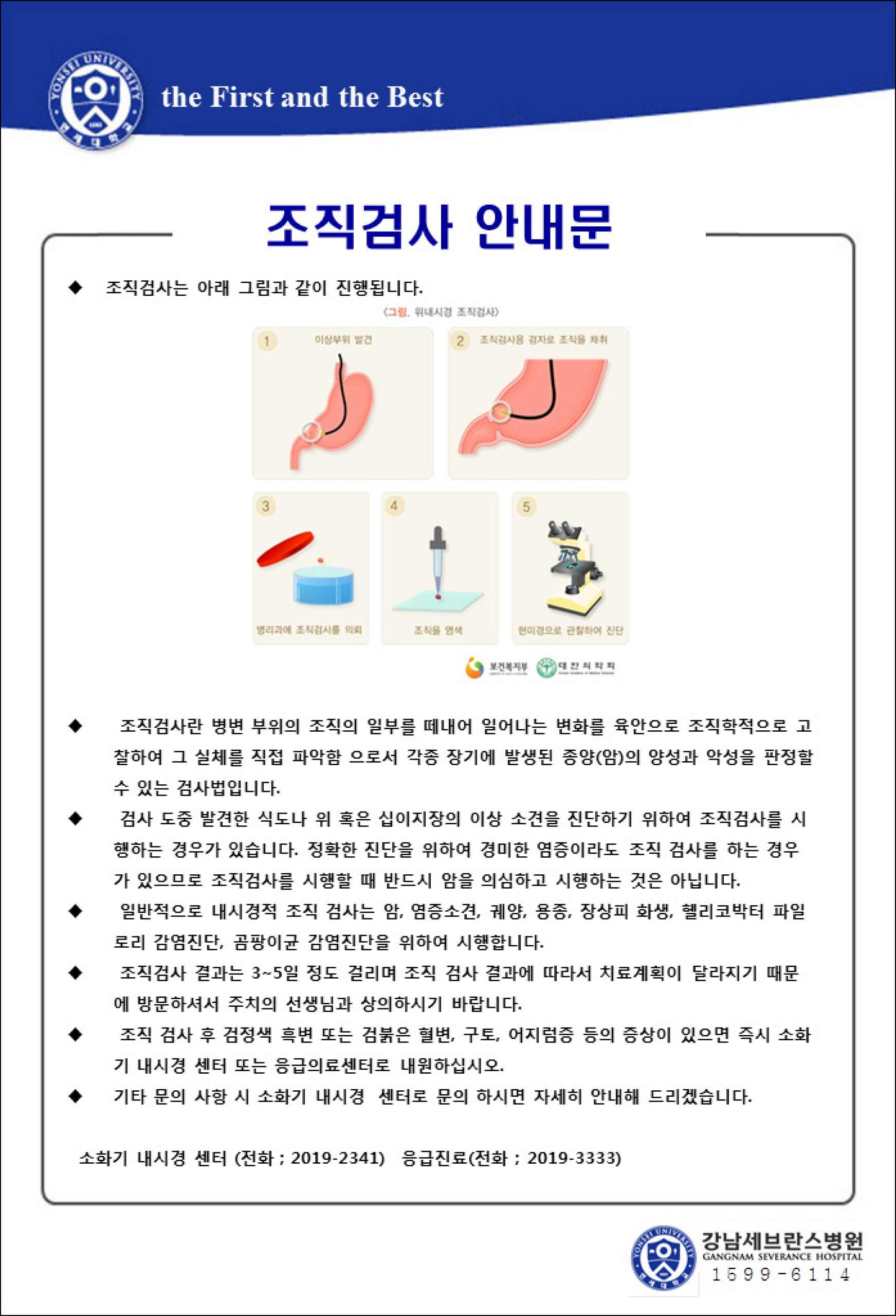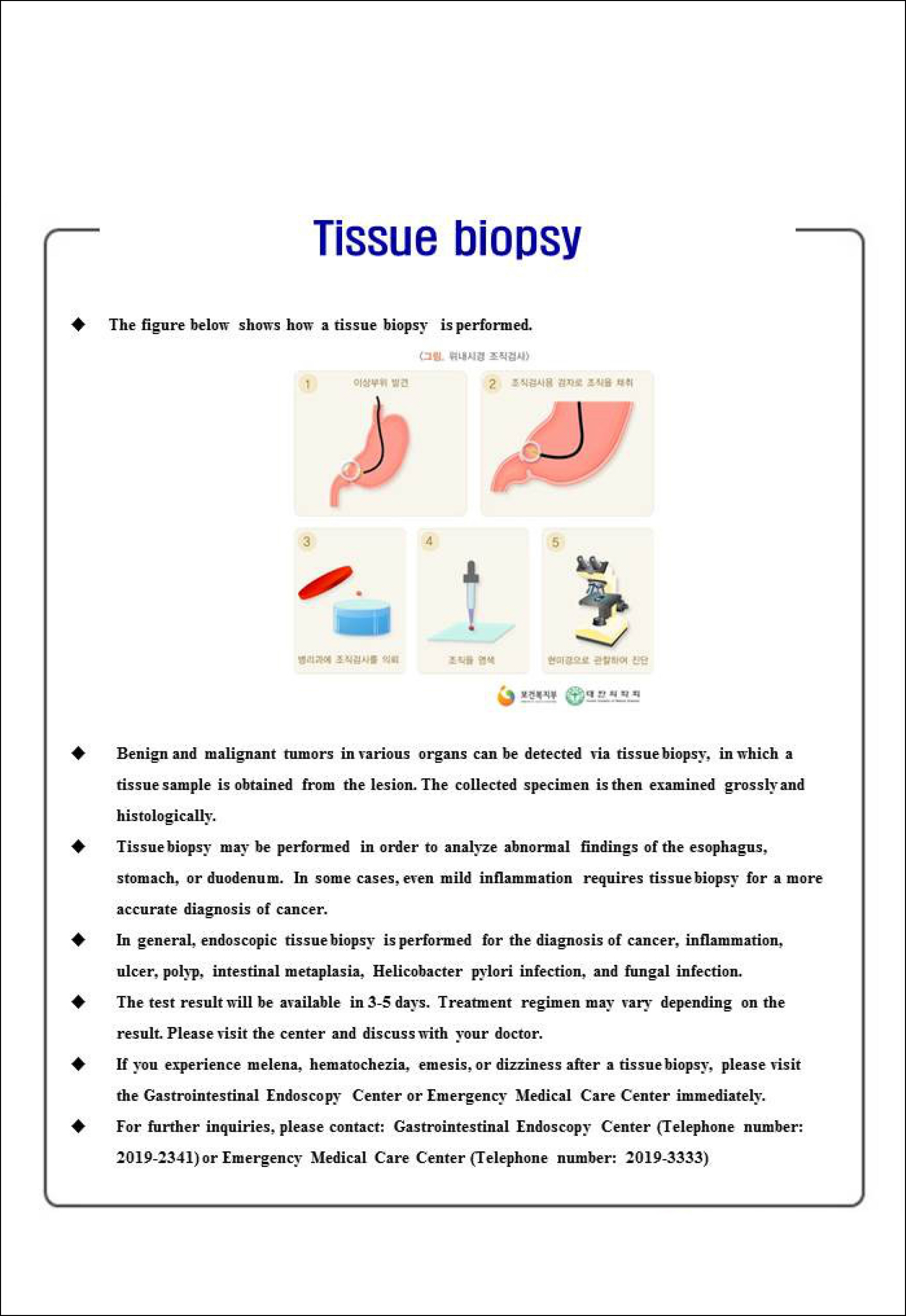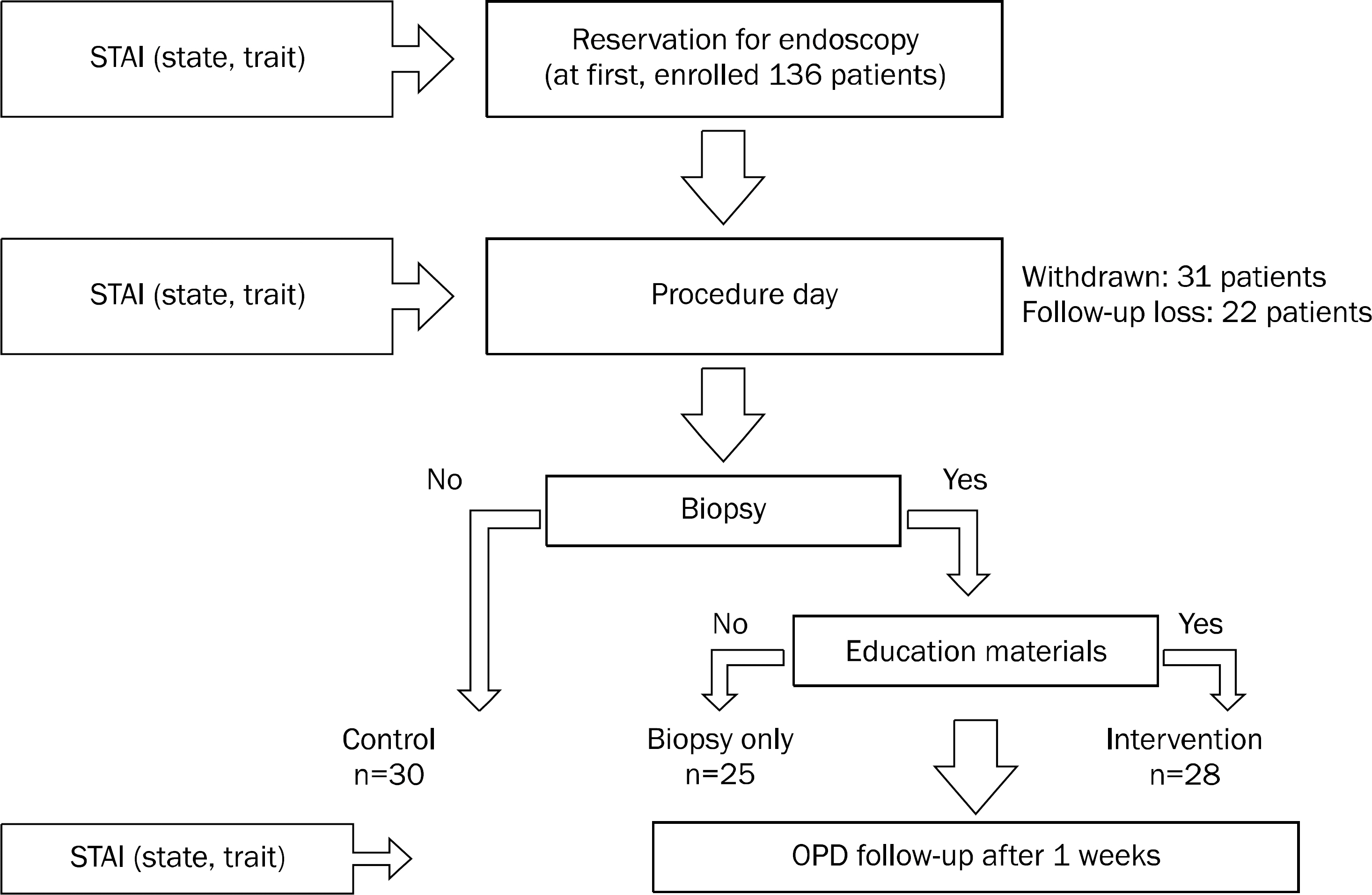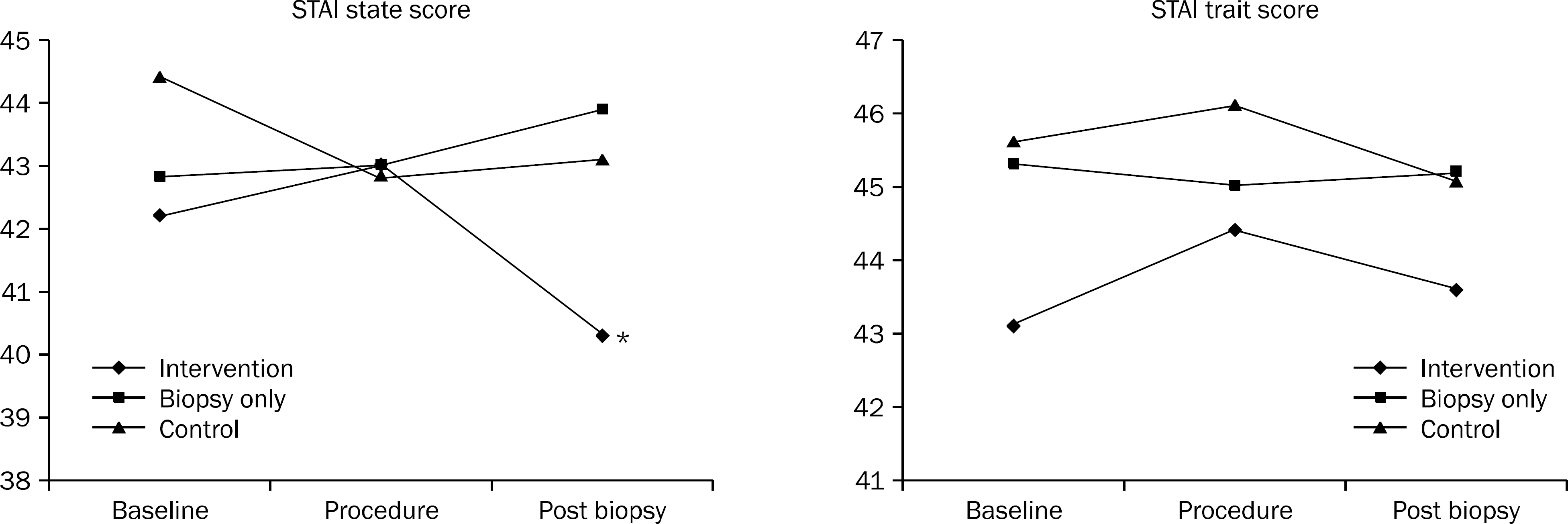Korean J Gastroenterol.
2016 Feb;67(2):92-97. 10.4166/kjg.2016.67.2.92.
Written Educational Material Relieves Anxiety after Endoscopic Biopsy: A Prospective Randomized Controlled Study
- Affiliations
-
- 1Department of Internal Medicine, Gangnam Severance Hospital, Yonsei University College of Medicine, Seoul, Korea. hjpark21@yuhs.ac
- 2Department of Psychiatry, Gangnam Severance Hospital, Yonsei University College of Medicine, Seoul, Korea.
- KMID: 2383547
- DOI: http://doi.org/10.4166/kjg.2016.67.2.92
Abstract
- BACKGROUND/AIMS
Patients who undergo endoscopic biopsy suffer anxiety until results are confirmed. This study assesses the effects of written educational material on the anxiety level of patients following endoscopic biopsy.
METHODS
This study was a randomized controlled study trial with 83 patients divided into the following three groups: a biopsy group given written educational material prepared by our institution following the biopsy (intervention group, n=28), a biopsy group without written material (biopsy only group, n=25), and a control group without biopsy (control group, n=30). The anxiety level of each patient was evaluated three times using Spielberger's State-Trait Anxiety Inventory (STAI): for baseline at the first visit to our institution, at the day of endoscopy, one day later, and one week after the procedure. We compared baseline characteristics, STAI scores at each visit, and differences in STAI scores among the three groups.
RESULTS
No difference was found in STAI score among groups at baseline and before and after the endoscopic procedure. However, the STAI-state score of the intervention group was slightly lower than biopsy only group one day post-procedure (40.3+/-7.7 vs. 43.9+/-7.1, p=0.135). The STAI-state score significantly decreased from pre- to post-procedure only in the intervention group (-2.75+/-6.1 vs. 0.92+/-4.0, p<0.027).
CONCLUSIONS
Use of written educational material for patients having biopsy might lessen their anxiety level.
MeSH Terms
Figure
Reference
-
References
1. Rollbusch N, Mikocka-Walus AA, Andrews JM. The experience of anxiety in colonoscopy outpatients: a mixed-method study. Gastroenterol Nurs. 2014; 37:166–175.2. Ersöz F, Toros AB, Aydoğ an G, Bektaş H, Ozcan O, Arikan S. Assessment of anxiety levels in patients during elective upper gastrointestinal endoscopy and colonoscopy. Turk J Gastroenterol. 2010; 21:29–33.
Article3. Maguire D, Walsh JC, Little CL. The effect of information and behavioural training on endoscopy patients' clinical outcomes. Patient Educ Couns. 2004; 54:61–65.
Article4. Rudin D. Frequently overlooked and rarely listened to: music therapy in gastrointestinal endoscopic procedures. World J Gastroenterol. 2007; 13:4533.
Article5. Salmore RG, Nelson JP. The effect of preprocedure teaching, relaxation instruction, and music on anxiety as measured by blood pressures in an outpatient gastrointestinal endoscopy laboratory. Gastroenterol Nurs. 2000; 23:102–110.
Article6. Luo YY. Effects of written plus oral information vs. oral information alone on precolonoscopy anxiety. J Clin Nurs. 2013; 22:817–827.
Article7. Zigmond AS, Snaith RP. The hospital anxiety and depression scale. Acta Psychiatr Scand. 1983; 67:361–370.
Article8. Hahn DW, Lee CH, Chon KK. Korean adaptation of Spielberger's STAI (K-STAI). Korean J Health Psychol. 1996; 1:1–14.9. Spielberger CD, Gorsuch RL, Lushene PR, Vagg PR, Jacobs AG. State-Trait anxiety inventory (Form Y). Palo Alto, CA: Mind Garden;1983.10. Millar K, Jelicic M, Bonke B, Asbury AJ. Assessment of preoperative anxiety: comparison of measures in patients awaiting surgery for breast cancer. Br J Anaesth. 1995; 74:180–183.
Article11. Kain ZN, Mayes LC, Cicchetti DV, Bagnall AL, Finley JD, Hofstadter MB. The Yale Preoperative Anxiety Scale: how does it compare with a "gold standard"? Anesth Analg. 1997; 85:783–788.12. Jones MP, Ebert CC, Sloan T, et al. Patient anxiety and elective gastrointestinal endoscopy. J Clin Gastroenterol. 2004; 38:35–40.
Article13. Campo R, Brullet E, Montserrat A, et al. Identification of factors that influence tolerance of upper gastrointestinal endoscopy. Eur J Gastroenterol Hepatol. 1999; 11:201–204.
Article14. Trevisani L, Sartori S, Putinati S, et al. Assessment of anxiety levels in patients during diagnostic endoscopy. Recenti Prog Med. 2002; 93:240–244.15. van Zuuren FJ, Grypdonck M, Crevits E, Vande Walle C, Defloor T. The effect of an information brochure on patients undergoing gastrointestinal endoscopy: a randomized controlled study. Patient Educ Couns. 2006; 64:173–182.
Article16. Drossman DA, Brandt LJ, Sears C, Li Z, Nat J, Bozymski EM. A preliminary study of patients' concerns related to GI endoscopy. Am J Gastroenterol. 1996; 91:287–291.17. Morgan J, Roufeil L, Kaushik S, Bassett M. Influence of coping style and precolonoscopy information on pain and anxiety of colonoscopy. Gastrointest Endosc. 1998; 48:119–127.
Article18. Aabakken L, Baasland I, Lygren I, Osnes M. Development and evaluation of written patient information for endoscopic procedures. Endoscopy. 1997; 29:23–26.
Article19. Callaghan P, Chan HC. The effect of videotaped or written information on Chinese gastroscopy patients' clinical outcomes. Patient Educ Couns. 2001; 42:225–230.
Article20. Bytzer P, Lindeberg B. Impact of an information video before colonoscopy on patient satisfaction and anxiety: a randomized trial. Endoscopy. 2007; 39:710–714.21. Felley C, Perneger TV, Goulet I, et al. Combined written and oral information prior to gastrointestinal endoscopy compared with oral information alone: a randomized trial. BMC Gastroenterol. 2008; 8:22.
Article22. Brandt LJ. Patients' attitudes and apprehensions about endoscopy: how to calm troubled waters. Am J Gastroenterol. 2001; 96:280–284.
Article
- Full Text Links
- Actions
-
Cited
- CITED
-
- Close
- Share
- Similar articles
-
- Effects of Written Information for Coronary Artery Disease Depending on Patients' Health Literacy on Health Behavior Compliance Related Self-efficacy, Knowledge of Disease, Anxiety, and Educational Satisfaction
- Effects of the Provision of Information on Anxiety in Patients during Outpatient Surgery: A Systematic Review
- Effects of a Navigation Program for Patients with Newly Diagnosed Gastric Cancer: A Randomized Controlled Trial
- The Prevention of Pancreatitis after Endoscopic Papillectomy; Stent versus No Stent
- The Effects of Educational Video Program Delivered Using Tablet PC on Physical Discomfort, Uncertainty, State Anxiety, and Nursing Education Satisfaction among Early Gastric Cancer Patients Undergoing Endoscopic Submucosal Dissection





